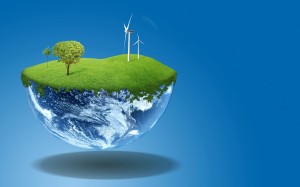9. Green Energy
Green Energy
~~~~~~~~~~~~~~~~~~~~~~~~~~~~~~~~~~~~~~~~~~~~~~~~~~~~~~~~~~~~~~~~~~~~~~~~~~~~~~~~~~~~
~~~~~~~~~~~~~~~~~~~~~~~~~~~~~~~~~~~~~~~~~~~~~~~~~~~~~~~~~~~~~~~~~~~~~~~~~~~~~~~~~~~~
UK Renewable Energy Options: A Brief Overview
Renewable energy is so called because it relies on natural energy flows and sources in the environment, which, since they are continuously replenished, will never run out. The UK is well placed: it has amongst the world’s largest resources of wind, wave and tidal energy.
Wind turbines sited in windy parts of the countryside could in principle generate perhaps 20% of the UK’s electricity, while the potential for wind turbines mounted in shallow water off-shore is even larger – perhaps up to 50% of UK electricity requirements, although the cost would be higher than for on-land machines. Typical large modern wind turbines have a rated output (at full power) of 1000 – 2000 kilowatts. They are usually grouped together in `wind farms’.
Wind moving over water creates waves, and the UK wave energy potential, if suitable floating devices could be located in deep water out to sea, (i.e. `deep-sea’ systems) could be up to 20% or more of UK electricity requirements. Smaller amounts of power, at possibly less cost, could be obtained from devices operated nearer to the shore, (`in-shore’ or `coastal’ systems) and from shore mounted units e.g. sited in gullies, (`on-shore’ systems).
The gravitational pull of the moon and the sun on the seas, produces two tides per day as the earth rotates. The high tides can be trapped behind a `barrage’ on suitable estuaries, creating a head of water which, when released, can be used to drive turbines, as with low head hydro-electric plants. Like some existing hydro schemes, some tidal barrages might be large. For example, the scheme proposed for the Severn Estuary would have around 8000 megawatts of installed generating capacity and could supply 6% of UK electricity requirements. The total UK tidal barrage potential is around 20% of UK electricity requirements.
In addition, the fast moving tidal streams in some areas (e.g. around Scotland and the Channel Islands) can also be used to generate power, using propeller type devices located in the flow. If all suitable tidal stream sites were used, they might provide up to 19% of UK electricity requirements.
More conventionally, although the energy potential is relatively limited, electricity can be generated form the flow of rivers and even streams, via small low head /’run of the river’ hydro electric turbines, as well as via the more familiar and larger hydro electric dams; with their construction costs now paid off, the latter produce the cheapest electricity in the UK.
In addition to these electricity supplying options, the UK has, surprisingly, a significant solar energy potential, the currently most cost-effective way of exploiting it being via well insulated `passive solar’ houses, designed with large south facing windows to trap solar heat.
Solar energy can also be converted into electricity via the photovoltaic `solar cell’ , and solar energy is of course the key power source for plant (and animal) life via photosynthesis. The harvesting of `energy crops’ looks increasingly likely to provide a significant source of `bio-fuels’ of various sorts – liquids (like ethanol and bio-diesel) for transport use, and gases (like methane), or solids (eg wood) used for heating or electricity production.
Short rotation ‘coppicing’ of rapid growing willow or poplar is one option, with the resultant wood chips being converted in a gasifier plant to produce hot gasses, which in turn are used to drive electricity-producing gas and steam turbines. This could become a major new energy source.
Some industrial and domestic wastes can also be used also be used as fuel , although there has been some concern expressed by environmentalists over emissions from waste combustion plants, and not everyone would see waste as strictly ‘renewable’.
Similarly, collecting heat from `geothermal’ sources deep underground is not strictly renewable – the geothermal wells would be gradually exhausted. But the energy potential is quite large – perhaps 10% of UK electricity requirement from `hot dry rock’ deep underground.
The UK already obtains about 2% of its electricity from renewable sources, chiefly from large to medium scale hydro-electric plants. There is some potential for expansion of medium and small scale hydro, but wind and waste projects are now being developed around the country on a significant scale and energy crops seen as the next likely area for development. The Government has however relegated offshore wind, wave and tidal energy to the long shot categeory, on the basis of cost, although it would seems unlikely, given the UK’s maritime history and extensive offshore engineering expertise, for these quite considerable energy resources to be ignored indefinitely.
~~~~~~~~~~~~~~~~~~~~~~~~~~~~~~~~~~~~~~~~~~~~~~~~~~~~~~~~~~~~~~~~~~~~~~~~~~~~~~~~~~~~
~~~~~~~~~~~~~~~~~~~~~~~~~~~~~~~~~~~~~~~~~~~~~~~~~~~~~~~~~~~~~~~~~~~~~~~~~~~~~~~~~~~~
World Overview
Germany, Austria and the UK (which has just launched an innovative ‘pay as you save’ initiative) are all looking at ways to bring existing buildings up to the energy performance standards required for new structures, as well as encouraging adoption of renewable micro-generation.
The issue is also on the agenda of European policymakers as they realise that — rather like the owner of a bath tub with a leaky plug — an unacceptable amount of energy is being wasted.
With the exception of a still-tiny number of buildings and enterprises, heating and power from both renewable and fossil fuels continues to leak away through the fabric of existing buildings, through inefficient appliances and devices used inside those buildings, and through unnecessarily hungry industrial processes and transport. The International Energy Agency estimates that globally, no less than 90 GW of power generating capacity is running just to supply appliances with standby power — and without further measures this will be 107 GW by 2020.
A massive programme to put the plug in Europe’s buildings could reduce heating and cooling demand by 75%–80%, and more in some cases. A key to this will be the so-called ‘recast’ of the Energy Performance of Buildings Directive, which expands on the original Directive adopted in 2002.
The spectacularly cold winter experienced by Europe should increase the appeal of the ‘deep refurbishment’ treatment that can dramatically reduce buildings’ energy consumption while also providing a more comfortable living or working environment. In the first week of March, the World Sustainable Energy Days’ conference on low-energy building renovation focused on how the massive existing building stock within Europe (and to some extent the U.S.) could be updated for the 21st century.
For while building regulations for new constructions are increasingly stringent (some countries already set on zero or near-zero carbon standards within a decade), the vast majority of buildings that will be in use in 2050 are the ones that are already in use. Across Europe, many homes and commercial buildings are already at least a century old, built for a different era with different expectations.
Europe’s building sector accounts for about 40% of current energy consumption, and 36% of Europe’s CO2 emissions — that’s heating and cooling plus the use of appliances and equipment. (U.S. figures are broadly similar.) More specifically, just the heating and cooling of buildings accounts for a quarter of the energy used in Europe. Advocates of deep refurbishment have calculated — and built examples have demonstrated — that heating and cooling demand can be reduced by 80%, ultimately shaving 20% off Europe’s energy demand. The European Commission believes that a 6% saving could be achieved through these measures by 2020 — the equivalent of the total energy consumption of Belgium and Romania — and CO2 emissions could be reduced by 5%.
According to Richard Bradley, head of the Energy Efficiency and Environment Division at the International Energy Association (IEA), if best-practice policies and examples were implemented globally, and fast, energy use for buildings (heating, cooling, ventilation and hot water) could be reduced far beyond 50%. In fact, he says, 75% reductions compared with business-as-usual would be ‘both possible and rational’. It’s not simply a matter of keeping warmer in winter — appropriate insulation and building adaptation can also be effective in stabilizing indoor temperatures, potentially a lifesaver during heatwaves.
One of the strong and consistent messages from the sector experts is that ‘deep’ renovation or refurbishment is essential. In fact, investing too little and not going deep enough is — while not exactly counterproductive – potentially damaging as a ‘shallow’ refurbishment takes resources, takes a building off the ‘to do’ list, yet does not deliver the full potential. According to the European Council for an Energy-Efficient Economy (eceee), the space heating target to aim for is 25-40 kWh/m², which typically represents savings of 80%–90%.
Typically a deep refurbishment will involve the addition of extensive wall insulation (preferably exterior, but in some cases interior), plus roof insulation, floor insulation, and low U-value windows. Heating becomes far less significant as so little heat is lost, but clearly should be super efficient, and ideally provided by renewables. In a building of this thermal quality, the use of heat pumps (sometimes controversial because of their electric load) now makes energy sense as the heating load is so slight. The addition of other microgeneration technology, such as photovoltaics, is also a key part of this strategy, sometimes making these properties net generators of energy.
There is no Europe-wide efficiency requirement for refurbishment as yet, though Germany and Austria are tending to renovate towards the PassivHaus standard used in those countries. Both Germany and Austria have successful, extensive refurbishment programmes in place. The UK government is a later starter, having set a target of achieving 80% (originally 60%) in household carbon emissions by 2050, compared with 1990 levels.
The vast majority of savings will need to be achieved in the existing built sector. There is a plan to tackle refurbishment head on, with an innovative ‘Pay As You Save’ scheme (announced early March) that extends long-term loans (20 to 30 years) to building owners to do refurbishments, the idea being that they repay from the savings on utility bills. This is currently being trialled in the Severn Wye region and others, and is also designed to encourage uptake of renewable generation technologies.
Gerhard Dell, who runs the Upper Austrian EnergieSparVerband, says his region of Austria undertook deep renovation of over 11,000 dwellings in 2009, both single family and apartments, and there are a further 300,000 dwellings to work on. Investment so far has been €250 million (US$343 million).
Of course there are challenges in convincing and training an often-conservative building industry to take on the new task. Martin Elsberger of the European Commission says that 280,000 to 400,000 jobs could emerge, putting back to work a sector that has been hit hard by the economic downturn. Another issue is to switch on building owners to the opportunities and to get them to ‘buy in’ to extensive changes — whether as owners or tenants — for homes or workplaces. Simply taking the opportunity to include insulation measures whenever other work is being done needs to become an obvious step.
The recast Directive will have several new requirements — for instance requiring all buildings undergoing major renovation to include energy efficiency measures (at present it is a requirement only for buildings over 1000 m2), and the energy performance certificate to be visible when a property is being sold. It will also introduce a benchmarking system.
One of the key issues coming up as the European Commission refines its guidelines is availability of appropriate financing.
MEP Claude Turmes cautioned that even the best current financing models are designed for shallow refurbishment. Most experts suggest a refurbishment cost of €25,000 ($34,000) for a single family house — so this clearly requires considerable upfront investment.
It’s something that needs to be looked at in the wide terms of energy planning, health, employment — and carbon reductions. As eceee’s Rod Janssen summed up: ‘It’s not the cost of deep renovation. It’s the cost of no deep renovation’.
~~~~~~~~~~~~~~~~~~~~~~~~~~~~~~~~~~~~~~~~~~~~~~~~~~~~~~~~~~~~~~~~~~~~~~~~~~~~~~~~~~~~
~~~~~~~~~~~~~~~~~~~~~~~~~~~~~~~~~~~~~~~~~~~~~~~~~~~~~~~~~~~~~~~~~~~~~~~~~~~~~~~~~~~~
The world population in the year 2100 will be in excess of 12 billion. If the current trends in technological progress and innovation continue, the demand for energy then will be five times greater than what it is now. If we continue the policy of using coal, oil and gas at the present rate, then by the year 2010 the global temperature will have increased by two degrees Celsius. We do not need reminding of the adverse effects of this: the increased risk of flooding in lowland areas, the processes of desertification, and changing climate all over the world.
It is a known fact that at the present moment renewable energy contributes only 11% to our primary energy. If we intend to do something about our planet, to safeguard our future and to create a healthy environment for the generations to come, then we must all actively utilize renewable energy in our daily life. It is expected that 60% of all our energy will come from renewable energy by the year 2070. The sooner we employ the attitude that today is better than tomorrow, the greater the opportunity to increase this figure to 80%. The World Solar Summit, World Solar Decade and the World Bank have recently allocated over two billion dollars to projects dealing with renewable energy and the environment. This clearly demonstrates the importance of renewable energy as the new source of power for the future.
~~~~~~~~~~~~~~~~~~~~~~~~~~~~~~~~~~~~~~~~~~~~~~~~~~~~~~~~~~~~~~~~~~~~~~~~~~~~~~~~~~~~
~~~~~~~~~~~~~~~~~~~~~~~~~~~~~~~~~~~~~~~~~~~~~~~~~~~~~~~~~~~~~~~~~~~~~~~~~~~~~~~~~~~~
Despite the severe downturn of the global economy in 2009, renewable energy continued its meteoric rise. At the end of 2009, fully one quarter of global power capacity (1230 GW) is renewable, delivering 18 percent of global electricity supply, according to the report issued by the Renewable Energy Network for the 21 Century (REN21) [1-3]. This is more than three times the global nuclear generating capacity and about 38 percent the capacity of fossil fuel-burning power plants worldwide. Renewable energy is [3] “hitting a tipping point”, said Christopher Flavin of Worldwatch Institute, one of the seven authors of the report, “there is now good reason to be optimistic.”
Despite lower oil prices, the lack of progress with climate talks, and other economic sectors declining around the world, renewable capacity continued to climb at rates close to those in the past years [4] (see Green Energies – 100% Renewable by 2050, ISIS Publication). Investment in new renewable power capacity in both 2008 and 2009 represented over half of total global investment in new power generation [2]. As Mohammed AlAshry, Chair of REN21 remarks [3]: “In 2009, governments stepped up efforts to steer their countries out of recession by transforming industries and creating jobs. This gave a boost to the renewable energy sector.”
Grid-connected solar photovoltaic (PV) rose 53 percent, wind power 32 percent, solar hot water/heating 21 percent, geothermal power 4 percent, and hydropower 3 percent. Production of ethanol and biodiesel increased by 10 and 9 percent respectively, even as layoffs and ethanol plant closures occurred in the United States and Brazil [1].
For the second year running in both US and Europe, more renewable power capacity was added than conventional (coal, gas, nuclear). Renewables accounted for 60 percent of newly installed power capacity in Europe in 2009, and nearly 20 percent of annual power production.
China came top of the world with 37 GW renewable power capacity added to reach 226 GW of total renewable energy capacity. Global renewable energy capacity increased by nearly 80 GW; 31 GW hydro and 48 GW non-hydro, of which 38 GW was wind power.
China was top market for wind power with 13.8 GW added, up from just 2 percent market share in 2004. The US was second with 10 GW added. The share of wind power reached new heights of 6.5 percent in Germany and 14 percent in Spain
Solar PV additions totalled 7 GW, reaching a total of 24 GW worldwide (of which 4 GW is non-grid connected [4]). Germany was top market with 3.8 GW. Other large markets were Italy, Japan, US, Czech Republic and Belgium. Nearly 11 GW solar PV was produced; a 50 percent increase over 2008.
Biomass power plants exist in over 50 countries around the world and supply a growing share of electricity. Several European countries are expanding their total share of power from biomass, including Austria (7 percent), Finland (20 percent), and Germany (5 percent).
Biogas for power generation is also a growing trend in several countries especially China, Sweden, and Germany [2], and now the UK [5].
~~~~~~~~~~~~~~~~~~~~~~~~~~~~~~~~~~~~~~~~~~~~~~~~~~~~~~~~~~~~~~~~~~~~~~~~~~~~~~~~~~~~
~~~~~~~~~~~~~~~~~~~~~~~~~~~~~~~~~~~~~~~~~~~~~~~~~~~~~~~~~~~~~~~~~~~~~~~~~~~~~~~~~~~~
The main advantages of renewables sources of energy such as solar, wind, anaerobic digestion, small hydroelectric, is that they are less capital intensive, easier to install and maintain than conventional non-renewable power plants such as nuclear, coal, and gas [2]. Consequently, developing countries can leap-frog to low or zero-carbon economies by improving energy efficiency, adopting organic agriculture, and installing affordable off-grid renewable power for the people [6] (Green Growth for Developing Nations, SiS 46).
Indeed, developing countries have more than half of global renewable power capacity [3], though much dominated by China and India. China leads in several indicators of market growth (see Table 1), while India is fifth in total wind power capacity, and rapidly expanding many forms of rural renewables such as biogas and solar PV. Brazil produces virtually all of the world’s sugar-derived ethanol and has been adding new biomass and wind power plants.
A new geographic diversity (and dominance) in renewable energies is emerging. Wind power existed in just a handful of countries in the 1990s, but is now found in over 82 countries. Manufacturing leadership is shifting from Europe to Asia as countries like China, India, and South Korea continue to increase their commitments to renewable energy.
In 2009, China produced 40 percent of the world’s solar PV supply, 30 percent of the world’s wind turbines, up from 10 percent in 2007, and 77 percent of the world’s solar hot water collectors.
Latin America is seeing many new biofuels producers in countries like Argentina, Brazil, Colombia, Ecuador, and Peru, as well as expansion in many other renewable technologies, though biofuels are not a sustainable option in countries where food production competes with fuel for land (see [7] Land Rush’ as Threats to Food Security Intensify, SiS 46). In fact, investment in new biofuel plants declined, as corn ethanol production capacity was not fully utilized in the US, and several firms went bankrupt. The Brazilian sugar ethanol industry similarly saw no growth. Europe faced similar decline in biodiesel, with low utilization in production capacity [3].
At least 20 countries in the Middle East, North Africa, and sub-Saharan Africa have active renewable energy markets. Many renewables markets are growing at rapid rates in countries such as Argentina, Costa Rica, Egypt, Indonesia, Kenya, Tanzania, Thailand, Tunisia, and Uruguay. Developing countries now make up over half of all countries with policy targets (45 out of 85 countries) and also make up half of all countries with some type of renewable energy promotion policy (42 out of 83 countries).
Apart from Europe and the United States, other developed countries like Australia, Canada, and Japan are seeing recent gains and broader technology diversification. The REN21 report comments [3]: “The increasing geographic diversity is boosting confidence that renewables are less vulnerable to policy or market dislocations in any specific country.”
~~~~~~~~~~~~~~~~~~~~~~~~~~~~~~~~~~~~~~~~~~~~~~~~~~~~~~~~~~~~~~~~~~~~~~~~~~~~~~~~~~~~
~~~~~~~~~~~~~~~~~~~~~~~~~~~~~~~~~~~~~~~~~~~~~~~~~~~~~~~~~~~~~~~~~~~~~~~~~~~~~~~~~~~~
~~~~~~~~~~~~~~~~~~~~~~~~~~~~~~~~~~~~~~~~~~~~~~~~~~~~~~~~~~~~~~~~~~~~~~~~~~~~~~~~~~~~
~~~~~~~~~~~~~~~~~~~~~~~~~~~~~~~~~~~~~~~~~~~~~~~~~~~~~~~~~~~~~~~~~~~~~~~~~~~~~~~~~~~~
~~~~~~~~~~~~~~~~~~~~~~~~~~~~~~~~~~~~~~~~~~~~~~~~~~~~~~~~~~~~~~~~~~~~~~~~~~~~~~~~~~~~
~~~~~~~~~~~~~~~~~~~~~~~~~~~~~~~~~~~~~~~~~~~~~~~~~~~~~~~~~~~~~~~~~~~~~~~~~~~~~~~~~~~~
~~~~~~~~~~~~~~~~~~~~~~~~~~~~~~~~~~~~~~~~~~~~~~~~~~~~~~~~~~~~~~~~~~~~~~~~~~~~~~~~~~~~
~~~~~~~~~~~~~~~~~~~~~~~~~~~~~~~~~~~~~~~~~~~~~~~~~~~~~~~~~~~~~~~~~~~~~~~~~~~~~~~~~~~~
~~~~~~~~~~~~~~~~~~~~~~~~~~~~~~~~~~~~~~~~~~~~~~~~~~~~~~~~~~~~~~~~~~~~~~~~~~~~~~~~~~~~
~~~~~~~~~~~~~~~~~~~~~~~~~~~~~~~~~~~~~~~~~~~~~~~~~~~~~~~~~~~~~~~~~~~~~~~~~~~~~~~~~~~~










